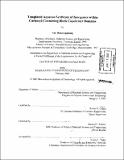Templated aqueous synthesis of inorganics within carboxyl-containing block copolymer domains
Author(s)
Boontongkong, Yot
DownloadFull printable version (53.45Mb)
Other Contributors
Massachusetts Institute of Technology. Dept. of Materials Science and Engineering.
Advisor
Robert E. Cohen and Michael F. Rubner.
Terms of use
Metadata
Show full item recordAbstract
Template-directed, aqueous-based syntheses of nanoscale inorganic materials in carboxyl-functionalized block copolymer domains (nanoreactors) were demonstrated. First, the successful application of electroless metal deposition within the sub-surface lamellar domains of an amphiphilic block copolymer is presented. Several electroless metals were selectively deposited inside the interconnected network of the water-permeable block domains containing pre-loaded palladium, which served as the spatially localized deposition catalyst. The technique proved to be a facile means to rapidly deposit large amounts of metals within the hydrophilic block domains, despite limitations on the transport of plating reagents into the bulk templates. The simple process yielded novel nanocomposites consisting of alternating layers of metal with those of the hydrocarbon matrix. The extent of metal deposition within the bulk block copolymer templates was controlled by adjusting the deposition rate and deposition time. Second, unique self-assembled thin film templates comprising in-plane arrays of nanosized surface cavities were investigated. The micellar thin films, formed by direct casting of kinetically stable styrene(PS)-acrylic acid(PAA) block copolymer reverse micelles from toluene onto solid substrates, consisted of lateral hexagonal arrays of spherical PAA domains in PS matrices. It was shown that hydration and swelling of PAA upon treatment in a monovalent base (NaOH) aqueous solution led to a cavitation process that exposed the PAA cores to the free surface. (cont.) The use of these cavitated PAA domains as open nanoreactors for the synthesis of corresponding nanocluster arrays following aqueous sequestration of metal ions into carboxyl-containing domains was demonstrated. Metal loading of the PAA domains could alternatively be achieved in the absence of cavitation by omitting the base treatment step, where the loaded PAA domains remained embedded within the original PS matrix. Additional stability was imparted to the nanoclusters synthesized within these closed nanoreactors relative to their cavitated counterparts. The option to employ either the open or the closed micellar templates represents a useful versatility of this system.
Description
Thesis (Ph.D.)--Massachusetts Institute of Technology, Dept. of Materials Science and Engineering, 2002. Includes bibliographical references.
Date issued
2002Department
Massachusetts Institute of Technology. Department of Materials Science and EngineeringPublisher
Massachusetts Institute of Technology
Keywords
Materials Science and Engineering.